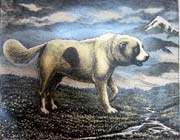Lithography in Iran ( part 2 )
After Sani-al-Molk, a few
Iranian artists either went to Europe to study lithography or learned it in Sani-al-Molk’s art school. These artists, with their knowledge of lithography, were hired for more prestigious positions.
One of them was Mirza Motaleb Esfahani, an artist working and teaching in Majma’-e Dar-al-Sanayeh [The Polytechnic School of Crafts]. (8) He was one of the first artists who illustrated a book using the technique of lithography; Tarikh Nameh Khusravan [The History of the Kings], written by Jalal-al-Doleh, (9) was first published in Tehran and then in Austria. Later Esfahani became the minister of the Department of Post and received the title of honor Mostashar-al-Vozara (meaning among all ministers) in Naser-al-Din Shah’s era. (10)
Other artists/lithographers found positions working for the newspapers of the time. One of those artists was Mirza Mehdi Khan, also known as Mosaver-al-Molk, whose father sent him to Majma’-e Dar-al-Sanayeh to learn painting. At the school he met Mirza Motaleb, who was still teaching painting. Mirza Motaleb encouraged Mosaver-al-Molk to go to the Dar-al-Fonoun School (11) to learn European realistic painting. At the Dar-al-Fonoun School, Mosaver-al-Molk learned to work with ink, watercolors, and lithography. With a strong knowledge of lithography, he was hired to publish his works in the newspaper Sharaf once a month during the last years of Naser-al-Din Shah’s reign.(12) Mosaver-al-Molk had his own techniques and painted the images directly on stone, instead of painting them on paper first and then transferring the image to the stone. The transfer process normally resulted in image flaking and loss of quality. With this method, Mosaver-al-Molk’s images were more controlled and of a superior quality than those using a transfer method.
Also, to avoid reversing the image when publishing, he copied the image using a mirror and painted the image on the stone by looking at the mirror.
Sixty-six issues of this newspaper were published from Safar 1314 A.H. until 1322 A.H. (1896–1904); in each number, a portrait of one of the shahs, or courtiers from Iran or other countries, was lithographed and signed by Mosaver-al-Molk. (13)
Another artist, Abou Tourab, Sani-al-Molk’s nephew and Kamal-al-Molk’s brother, worked for Sharaf newspaper at the same time.
Abou Tourab studied art at the Dar-al-Fonoun School and was trained under his uncle Sani-al-Molk. After learning lithography, he started working for Sharaf (14) as well as providing lithographs for books, the most important of which was the Second Travel to Khurasan written by Naser-al-Din Shah in 1882. (15) In his travels, Naser-al-Din Shah took a photographer with him to record different regions he visited. After returning from the trip, the monarch commissioned Abou Tourab to make lithographs based on the photographs. (16) His series of lithographs start with a portrait of the monarch that is not limited to photographic details and anatomical accuracy. (17) This image is an example of Sani-al-Molk’s influential artistic style on the next generation in conveying the sitter’s personality. The series continues with landscapes from small villages, gardens, the shah’s camping site, the governors’ houses in which Naser-al-Din Shah rested overnight, the Semnan Mosque,(18) monumental buildings, and some parts of the holy shrine of Imam Reza, the eighth Shi’ite Imam buried in Mashhad.(19) Abou Tourab signed each of his lithographs.

His proficiency as an artist and lithographer led him to become a court artist later. (20)
During the Qajar period, lithography became a new art form for making images for mass production. Lithography introduced European realistic painting as the art of the time to the Iranian society. The extensive use of Lithography in Iran decreased some of the limitations that ordinary people had in viewing images since they did not have access to the many original paintings that were kept in the palaces or the houses of the upper class families. Lithography, therefore, played a crucial role in educating the populace about their contemporary art, some Western and Iranian artists/lithographers, and the changes that occurred in Iranian art sphere. Also, the fact that middle-class people were able to purchase art in the form of lithographs affected the patronage of the time. From that time on, more people could afford images or illustrated books that were less expensive than the original paintings or hand illustrated books.
Moreover, the publication of newspapers and books with lithographed images such as portraits of well-known individuals and social events increased society’s awareness of image as a tool for expressing facts and opinions.
Other links:
Master Mohammad Baqer Aqamiri
Mohammad Reza ATASHZAD
Mahmoud Farshchian
Freydoon Rassouli
Aliakbar Sanati
Hamid Ajami